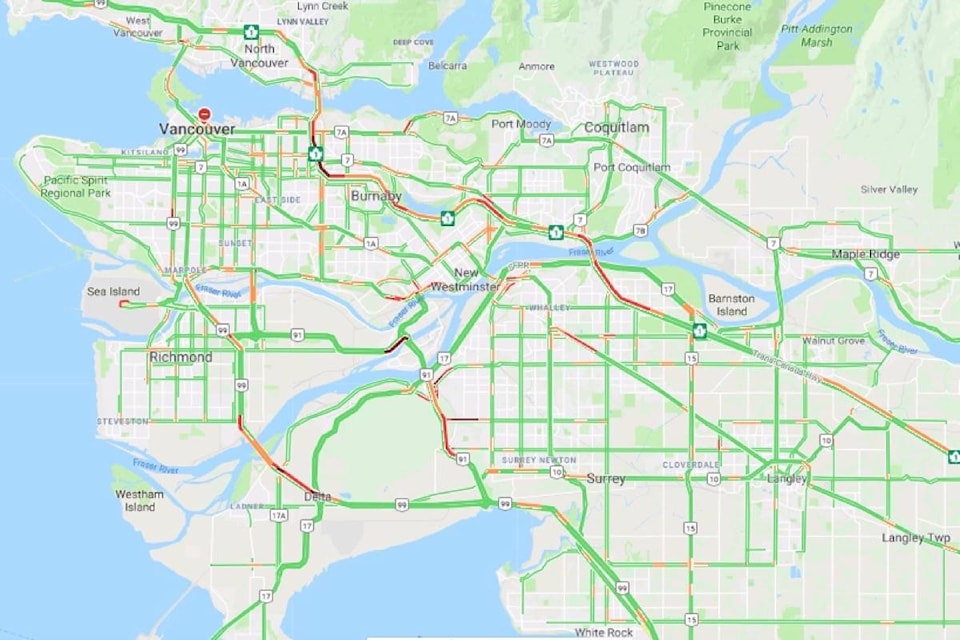A commission tasked with figuring out how mobility pricing should work in Metro Vancouver released its first report on Tuesday, outlining two possibilities: “congestion point” charges or distance-based charges.
The Independent Mobility Pricing Commission, set up by the mayors’ council on regional transportation last June and made up of business, union, academic and community leaders, was charged with determining with how the public should pay for much-needed transit and transportation projects in the region.
“Congestion point” charges would hit when a car drives by a specific point. That could mean bridges or tunnels, although commission chair Allan Seckel was quick to point out in a technical briefing with reporters that his group did not have any locations mapped out at this point. The charges would likely only be in place at busy times of day.
Distance-based charges would be per kilometre, based on the location and time of day that people were driving.
The commission said that the funds raised could help fund necessary transportation improvements like the new Massey Bridge and Pattullo replacement.
READ: Most Metro Vancouver residents support mobility pricing: report
Varying the distance-based charges by time of day hasn’t been done before, commission executive director Daniel Firth said, at least partially because of technological barriers.
“There is some technology on the horizon that looks like it could be interesting,” Firth said.
Distance-based charges, for example, would require some form of tracking drivers, Seckel acknowledged, and that the issue had come up in public feedback.
A congestion point system could render those privacy complaints less urgent, Firth said, by using similar transponders or licence plate cameras as did the toll bridges in Surrey and Maple Ridge.
The commission is focused, he said, on three key elements for any road pricing scheme: affordability, fairness and enough transportation options available so people can avoid the charges.
Seckel added the charges would remain affordable enough that people could choose to incur them if that route was more convenient to them over a free one.
Congestion point charges not like tolls
When asked how congestion point charges would differ from the bridge tolls taken off last fall, Firth said Metro Vancouver’s spread-out city centres could mean charge points in spots all around the region, not just at crossings.
Seckel said the commission was planning to provide examples near the end of January, saying “the congestion is a little spread out [across Metro Vancouver].”
Firth said they would have to be careful not to use congestion charges to deter people from city centres, though he acknowledged “congestion [itself] is equally like a sign saying, ‘Don’t come here.’”
“It’s about putting a charge at the right point within that congested system in order to be having an impact.”
| Congestion points in Metro Vancouver:1. Bridges and tunnels crossing the Fraser River2. Bridges between Richmond, Vancouver International Airport and Vancouver3. Major arterials in Vancouver and western parts of Burnaby4. Urban centres – for example New Westminster, Metrotown, Surrey City Centre and Richmond City Centre5. Various points across the North Shore6. The northeast part of the region – for example Coquitlam, Port Coquitlam andPort Moody7. Regional highways – for example Highway 1 and Highway 918. Metropolitan core of downtown Vancouver(Independent Mobility Pricing Commission) |
Mayors south of the Fraser River have long criticized the region’s now-defunct bridge tolls, saying they unfairly affected their constituents.
Drivers had avoided the tolled Port Mann and Golden Ears bridges, instead clogging up free alternatives such as the Pattullo Bridge. Transportation Ministry figures show traffic went up nearly 30 per cent on those two crossings once the tolls came off.
Seckel said the province’s old rule of needing to provide one non-tolled crossing per region as an alternative led to gridlock in the areas with the free option.
“If you drove through New Westminster during the times of the tolls,” he said, referring to the north end of non-tolled Pattullo Bridge, “there was a lot of congestion and people going through side streets to try and avoid it.”
Surrey Mayor Linda Hepner said it was too soon for her to judge if either charging method would be better than tolls.
“It’s really tough to say what the analysis of the two options would produce but I was pleased to see so many people engaged,” said Hepner on Tuesday morning.
“It’s not a surprise to me that they heard a lot of comments around the fairness of the system and that there is access to other options before there was decongestion charging put in place.”
Hepner noted that many of Surrey’s urban cores and main arterial routes were congested but said it was too early for her to say how congestion point charging might affect those.
Hepner did muse on the possibility of distance-based charging by time and place potentially taking truckers off the road during rush hour.
“If you’re travelling the the busiest time of the day as opposed to when you could be travelling to do deliveries at a less important time,” said Hepner.
“I expect that will all be part of the next analysis.
The end of the gas tax?
The commission hasn’t decided if other charges that drivers pay, such as the gas tax, should be phased out yet, but its members are considering it.
The final report is expected to be released in April. Online public consultation on the two options will run from mid-February to mid-March.
Firth said the commission expects, at least initially, some pushback against any new road pricing.
“In cities like London and Stockholm, opposition before it was implemented was maybe 60-70 per cent, and that tends to switch once the system itself is implemented.”
Like us on Facebook and follow us on Twitter.
